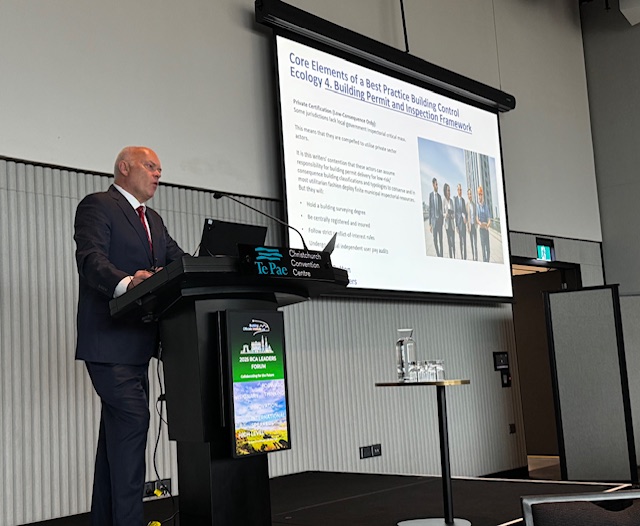
Adj. Prof. Kim Lovegrove addressing the 2025 BOINZ Annual Symposium & BCA Leaders Forum at Te Pae Christchurch Convention Centre.
Download and view Powerpoint below

Adj. Prof. Kim Lovegrove addressing the 2025 BOINZ Annual Symposium & BCA Leaders Forum at Te Pae Christchurch Convention Centre.
Download and view Powerpoint below
Filed Under: Articles Tagged With: best construction lawyers melbourne, building dispute lawyers, construction dispute resolution, construction dispute resolution lawyers, IBQC

The World Organization of Building Officials (WOBO) has acknowledged the work of Lovegrove & Cotton for their recent contributions to the International Building Quality Centre (IBQC). WOBO noted the firm’s involvement (in a WOBO update dated 28 March 2024) regarding IBQC guidelines, stating, “WOBO appreciates the work carried out by Lovegrove and Cotton and their recent updates in respect of IBQC.”
Members of the Lovegrove & Cotton team have been instrumental in assisting with the development of the IBQC Risk-Based Building Classification and Mandatory Inspection Guidelines. These guidelines were developed over 18 months, involving collaboration with leading professionals from the United States, United Kingdom, Australia, New Zealand, and Germany. The guidelines focus on implementing a risk-based approach to building classification and mandatory inspection processes.
On 28 March 2024, three key articles authored by Lovegrove & Cotton were republished by WOBO:



Lovegrove & Cotton acknowledges WOBO’s recognition and is very grateful. The firm also recognizes the important role that this highly regarded global body plays in advancing good practice approaches to building regulation and building control.
Lovegrove & Cotton will continue to support the development of robust building regulatory frameworks, in line with a tradition of helping to establish good practices in building control dating back more than 30 years.
Image Acknowledgements:
The digital renders used in this article were developed collaboratively by Lovegrove & Cotton and ChatGPT. The photo images that are not the digital renders are stock images sourced from Shutterstock.
Filed Under: Articles Tagged With: best construction lawyers melbourne, building act lawyers, building contract lawyer, building dispute lawyers, building dispute resolution, building disputes, construction dispute resolution, construction dispute resolution lawyers, construction disputes, construction lawyers

Tsigereda left Ethiopia in 2009. After an initial period of 4 months in Auckland, New Zealand, with her late mother-in-law, Tsigereda Lovegrove settled in Australia. She learned English as her second language and set her sights on a career in law.
Starting as a receptionist at Lovegrove & Cotton Lawyers in 2011, Tsigereda worked her way up within Lovegrove & Cotton, which was established in 1993 by the writer.
While working at the firm, Tsigereda embarked on an LLB at Victoria University. She balanced her studies with her role as Office Manager and Financial Controller, overseeing the firm’s financial and administrative operations. This experience laid a solid foundation for her future roles.
After completing her law degree, Tsigereda became a Construction Lawyer and Practice Manager at Lovegrove & Cotton. With 11 years of management experience, she now oversees practice management, ensuring the firm’s operations run efficiently while fostering a positive work environment. Since she became Practice Manager, the firm has grown by 300% in terms of full-time legal personnel.
Tsigereda’s legal practice covers a broad spectrum of construction law, including tribunal and court cases, building appeals, and building regulatory compliance in Victoria and NSW. She also provides advice on legislative interpretation of the Building Act 1993 and the Domestic Building Contracts Act.
In addition to her domestic legal work, Tsigereda serves as Secretary to the International Building Quality Centre (IBQC) Dispute Resolution Coalition. She coordinates efforts among a distinguished group of international legal experts, including senior jurists from Africa and Australia, as well as eminent construction lawyers from both hemispheres. In this capacity, she contributes to the development of dispute resolution protocols and building regulatory guidelines for emerging economies. She is also a member of the Victorian Building Disputes Practitioners Society Committee.
Her commitment to Africa in terms of the work she does on emerging economy guidelines is an intergenerational commitment to capacity development in Africa, as her grandfather-in-law worked for UNESCO in the 1950s and 60s in Addis in educational capacity building. The late Norman Lovegrove was instrumental in helping to establish mobile schooling where UN VW Combis transported teachers to the rural regions to make education more accessible.

Tsigereda has authored and co-authored several publications, focusing on key issues such as building insurance requirements, risk-based building classification, and inspection protocols for emerging economies.
“In the short time I have known Tsigereda ‘Ziggy’ Lovegrove, I have come to respect her diligence, capabilities, and tenacity. Set against the backdrop of a faraway homeland, Ziggy forged a new life for herself in Australia, conquered the English language, and raised a family. In her professional life, Ziggy is rightfully proud to have attained a law degree and become a protégé of the law firm that bears her husband’s name. Professionally, she has assisted the International Building Quality Centre in conducting background research, synthesizing material, and coordinating some of the logistics of international meetings, which has demonstrated her dexterity in familiarizing herself with topics that one can only imagine were quite foreign to her not so long ago.”
– Neil Savery, IBQC Board Member
“ In my interactions with Tsigereda, I have found her to be a remarkable force of intelligence, integrity, and professionalism. At the IBQC, she skillfully facilitated teamwork, ensuring that collaboration was smooth, insightful, and effective. Her exceptional communication and leadership skills were evident in these interactions.
Her extensive knowledge and research contributions on mediation as a dispute resolution mechanism have made a significant positive impact on the industry. Additionally, her strategic thinking and dedication to enhancing dispute resolution mechanisms in developing countries, such as Ethiopia, have left a lasting impression on me”.
– Judge/Justice Maedot Yeshak Tesfaye, Federal Court of Ethiopia .

Tsigereda is intent on growing the practice in Australasia, opening a New Zealand office, and continuing to participate in the development of building regulatory guidelines that are contextualized for Africa. Her commitment to advancing the industry reflects her dedication to making a positive difference both locally and globally.
This piece is penned by the founder of Lovegrove & Cotton Kim Lovegrove
Filed Under: Articles Tagged With: african female lawyers in Australia, African lawyers in Australia, best construction lawyers melbourne, building act lawyers, building contract lawyer, building dispute lawyers, building dispute resolution, building disputes, construction dispute resolution, construction dispute resolution lawyers, construction disputes, construction lawyers, Ethiopian lawyers in Australia that are fluent in English and Amharic, leading Australian construction lawyers, leading Melbourne construction lawyers, top construction lawyers, Tsigereda Lovegrove, women in construction law

Building control systems have undergone significant transformations over the years. Kim Lovegrove’s article examines these changes, highlighting what has worked, what hasn’t, and the valuable lessons learned along the way.
Lovegrove highlights that the best practice jurisdictions have certain characteristics that contribute to their success:

Lovegrove emphasizes the need for government-controlled registration and licensing systems. These systems should cover not only builders but also building surveyors, engineers, designers, and building inspectors. Such regulation ensures that all professionals involved in construction meet high standards of competence and integrity.
Lovegrove emphasizes the need for builders to be highly educated and trained. He argues that if builders are highly qualified in construction, technology, systems and methodology there would be fewer mistakes in construction. He is puzzled that engineers and architects are generally required to have degrees and yet builders in many countries are not. He adds that it is obvious that the better quality of the build the less of the need for constant checks by building surveyors. Builders must have formal qualifications in building to ensure they have the necessary skills and knowledge.
Building surveyors, also known as certifiers and building officials, play a crucial role in the construction process by ensuring that building work complies with regulations. Lovegrove notes that this role is fundamentally about insuring that there is compliance with building act and building codes. However, he argues that the best way to achieve high standards is to prevent mistakes from happening in the first place.

Lovegrove cautions against the dangers of deregulation in the building industry. While deregulation can make the market more flexible and competitive, it can also lead to inadequate oversight and increased risks for consumers. He highlights the example of New Zealand, which faced significant problems with leaky buildings due to deregulation.
Lovegrove identifies several reasons why building control systems can fail:
Lovegrove argues that the key issue is not about deregulation or overregulation but about regulating correctly. The goal should be to find a balance that ensures consumer protection while allowing for market flexibility. Effective regulation should protect public safety without stifling innovation or efficiency.

Drawing from his international experience, Lovegrove underscores the importance of learning from other countries’ experiences. He notes that many countries have tried different approaches to building control, with varying degrees of success. By studying these examples, policymakers can avoid repeating mistakes and implement best practices.
Lovegrove also highlights the importance of involving international experts in building regulation reforms. Governments should be open to leveraging the expertise of professionals who have designed effective regulatory systems in other countries. This approach can help ensure that reforms are well-informed and based on global best practices.
Reflecting on his extensive career and contributions to building law, Lovegrove advocates for a balanced approach to regulation that integrates best practices from around the world. Effective regulation should protect public safety without stifling innovation or efficiency. By implementing clear, centralized building legislation and maintaining strong oversight, jurisdictions can ensure high standards in construction while protecting consumers from the risks of poor-quality work. Engaging international experts and learning from global experiences can further enhance the effectiveness of building control systems. Law reformers should also have regard to the guidelines of the International Building Quality Centre (IBQC), the international thought leader hub on best practice approaches to the design of building regulation.
By following these guidelines, jurisdictions can create robust building control systems that balance consumer protection with market flexibility, ensuring high standards and safety in the construction industry.
Adjunct Professor Kim Lovegrove has a long history in building regulatory reform. He has served as a senior law reform consultant to the World Bank, and has contributed to international thought leadership in building regulation. He was the principal legal adviser of the development of the Australian National Model Building Act and has advised on law reform initiatives in Japan, India, and China. Lovegrove is also the inaugural Chair of the International Building Quality Centre and a past President of the Australian Institute of Building (Victoria) and NZIOB (Northern Chapter).
The information for this article was gathered from various writings and presentations by Kim Lovegrove, including his work with Lovegrove & Cotton Lawyers and his involvement with the International Building Quality Centre (IBQC). For more detailed insights, you can visit the LC Lawyers website and the IBQC website.
Disclaimer
This article is not legal advice rather a discussion of the topic in only general terms. The views expressed in this address are those of the writer and are not views of any origination he works for, chairs or represents.
Image Acknowledgements:
The digital renders used in this article were developed collaboratively by Lovegrove & Cotton and ChatGPT. The photo images that are not the digital renders are stock images sourced from Shutterstock.
Filed Under: Articles Tagged With: best construction lawyers melbourne, building contract lawyer, building dispute lawyers, construction dispute resolution lawyers, construction disputes, construction lawyers

The below piece that I have italicised for ease of reference was published in sourceable 9 years ago. It attracted 33,000 reads. I`ve re-released it (with a couple of minor edits) as the crises discussed in the article, the shrinking pool of certifiers hasn’t been solved nearly a decade later.
Jill Brookfield CEO of the Australian Association of Certifiers last week was quoted in the Daily Telegraph as saying “Make no mistake, the housing crises cannot be solved without certifiers”
“Is the era of Private Certification nearly over” sourceable 3 July 2015
“There is talk again a around the imminent demise of private certification. If this is correct, how did it get to this?
A trip down memory lane will provide some of the answers. Private certification was established in the early 1990s. By the mid-90s, it was prevalent in all Australian jurisdictions albeit in different guises.
The system allowed one to choose either a private certifier or a council building surveyor to issue building permits, carry out inspections and ultimately issue occupancy permits. In some jurisdictions like ACT, certifiers were tasked with carrying out some of the approval functions but the occupancy permits were issued by government. There were further permutations; in some jurisdictions they were called building surveyors, while in others, accredited certifiers.
It came into play to speed up the building approval process. Back in the day, before the system opened up (and I’m showing my age here), building permit issues was the sole domain of local government. Builders and owners complained that it could take weeks, sometimes months to get a building permit from a council.
I remember lodging a simple set of plans for a very minor renovation. When visiting the council building department I noticed that between the hours of 10am and 12pm, or 2pm and 4pm, I could be graced with access to a building surveyor. It was a good lifestyle job for the civil servants but a inconvenient for the rate paying customer.
Private certification revolutionised this and turnaround time plummeted as building surveyors competed with one another for building permit revenue.
When private certification was first introduced, the insurance products were fantastic. All building practitioners could get 10-year runoff cover.
Based on the French system, when a building practitioner retired, it triggered automatic runoff. This meant that the retiree was indemnified for 10 years post-retirement and consumers had the benefit of insurance protection for 10 years.
It was very good consumer protection. By the late-90s, however, the insurance industry said “enough.” They complained that the cost of underwriting the scheme was crippling and unsustainable. Fearing an underwriter exodus, the governments did away with mandatory requirement of runoff.
Further, the early 90s Model Act based reforms had intended that all building practitioners were required to be registered across the board. This only occurred in some jurisdictions like Northern Territory and Victoria. Other jurisdictions like New South Wales chose not to insist upon the registration of all building practitioners; they opted for a regime where only residential builders and private certifiers were required by law to be registered and insured.
So we had the emergence by the late-90s of profoundly divergent risk landscapes in the eight countries of Australia (i.e. the states and territories).
Then there was another thing that cut across the bow: in the mid-90s the ABCB introduced a performance based building code. This allowed building surveyors to sanction alternative solutions – to choose innovative often computer modelling based design scenarios, designed to comply with the objectives of the BCA – in lieu of design proposals complying with the prescriptive or deemed to satisfy provisions of the BCA.
This was all well and good, but it was a huge game changer as for the first time in Australia, building surveyors could issue building permits based upon alternative solution design scenarios that did not comply with the prescriptive provisions of the BCA.
A private certifier, armed with a building surveying qualification could ‘green light’ a development courtesy of an alternative solution that was not of the tried and true prescriptive regulation persuasion. Talk about a radical turn!
Now one had a proliferation of alternative solutions being sanctioned in areas like fire compliance, where sprinklers would be deleted as other methods of fire retardant persuasion were preferred.
Invariably some of the alternative solutions involving the likes of the deletion of sprinklers were a cheaper option than sprinkler-containing solutions. The risk barometer was ratcheted up against private certifiers on account of the massive assumption on alternative solution base risk.
At about the turn of the third millennium, the insurers arched up. Insurers descended upon government, insisting that they didn’t like to underwrite warranty cover for residential skyscrapers anymore. The risk was too high and they argued that they were losing money on multi-unit development claims.
They intimated that they would have to have to leave the market unless they were freed from underwriting the mandatory legislative requirement for sky-rise multi-storey dwellings.
The upshot was that insurers no longer underwrote residential high rises for builders. But here’s the thing: private building surveyors still had to carry general professional indemnity cover for high rise residential monoliths.
So the elevated status of private certifiers as highly desirable insured defendants went through gained momentum, particularly in jurisdictions like NSW where, unlike Victoria, certifiers had by default become the only professionals who were by law required to carry mandatory PI cover.
For fear of belabouring the point, this made certifiers very attractive to plaintiffs. In Victoria, on the other hand, engineers, architects, draftspersons and quantity surveyors are all required to be insured. Needless to say, the risk was spread more evenly.
Not surprisingly, in garden variety lawsuits – multi-defendant legal proceedings, that is – building surveyors increasingly found themselves locked in as co-defendants.
If not as co-defendants, they were joined as third parties and this in recent times has become the bane of the building surveying sector. The insurers began to see say ‘these guys as a bad risk, as they were popping up as co-defendants everywhere” and the London-based underwriters looking from afar began to get a little nervous about this antipodean creature called a private certifier (or is it an accredited certifier?).
Premiums went up and more and more certifiers began complaining about the difficulty in getting insurance cover. More and more frequently, one heard of certifiers having to look far and wide for cover to avoid closing shop and going out of business.
The deleterious impact of all of this on the risk profile has continued to coincide with fee cannibalisation and the habit of too many builders or developers screwing certifiers down on price. So we have an unholy coalescence of hefty and increasing premiums and cutthroat fee competition. Anecdotally, there is even talk of the insurance industry pulling out of the market altogether. None of this is surprising.
All of this means that the profession is being poleaxed every which way and the risk profile of the private certification sector has become increasingly dire. Compounding the problem is an ageing demographic, for the green shoots of youth are not coming through. Whenever I address a building surveyor conference, 80% of the audience members look like me: male, bald or grey, or both. Not surprising, we are all well north of 50 and take my word, 50-something is not the new 40-something.
More and more certifiers are telling me that the writing is on the wall. Unless there are some profound changes, this relatively new profession may be in its twilight. This has led to the rumours that now abound about it all returning to local government.
That may be well and good, depending on your point of view, but remember: in the post-GFC world there have been cutbacks to the funding of compliance departments. Latvia’s supermarket roof collapse, that killed many people, was in part due to the post-GFC austerity measures on account of the disbanding of the national building inspectorate.
Furthermore, builders and aspiring home owners should be on notice as swift permit delivery may be coming to an end. And for those who have, for so many years, screwed surveyors down on their fees, let’s see how the numbers will stack up when one is holding a development for an extra few months on account of permit delays in councils due to human resource constraints.”
Kim Lovegrove MSE RML is a partner of trans tasman lawyers, Lovegrove & Cotton, an author & law reformer, a Conjoint Professor at UWS University of Newcastle NSW & Chair of the IBQC and a past President of Northern Chapter, NZ
Disclaimer
This article is not legal advice rather a discussion of the topic in only general terms. Should you be in
need of legal advice, please contact a construction law firm. Lovegrove & Cotton Lawyers and
our experienced team will assist you based on the facts and circumstances of your case.
Filed Under: Articles Tagged With: best construction lawyers melbourne, building contract lawyer, construction lawyers, private certification
Our construction lawyers and senior construction and planning lawyers personally prepare articles and journals on a variety of construction and planning law matters. We invite you to submit your name and email address below to receive our regular eBulletin updates.
Lovegrove & Cotton © 2025. All Rights Reserved.
Terms of Use | Privacy & Security Statement